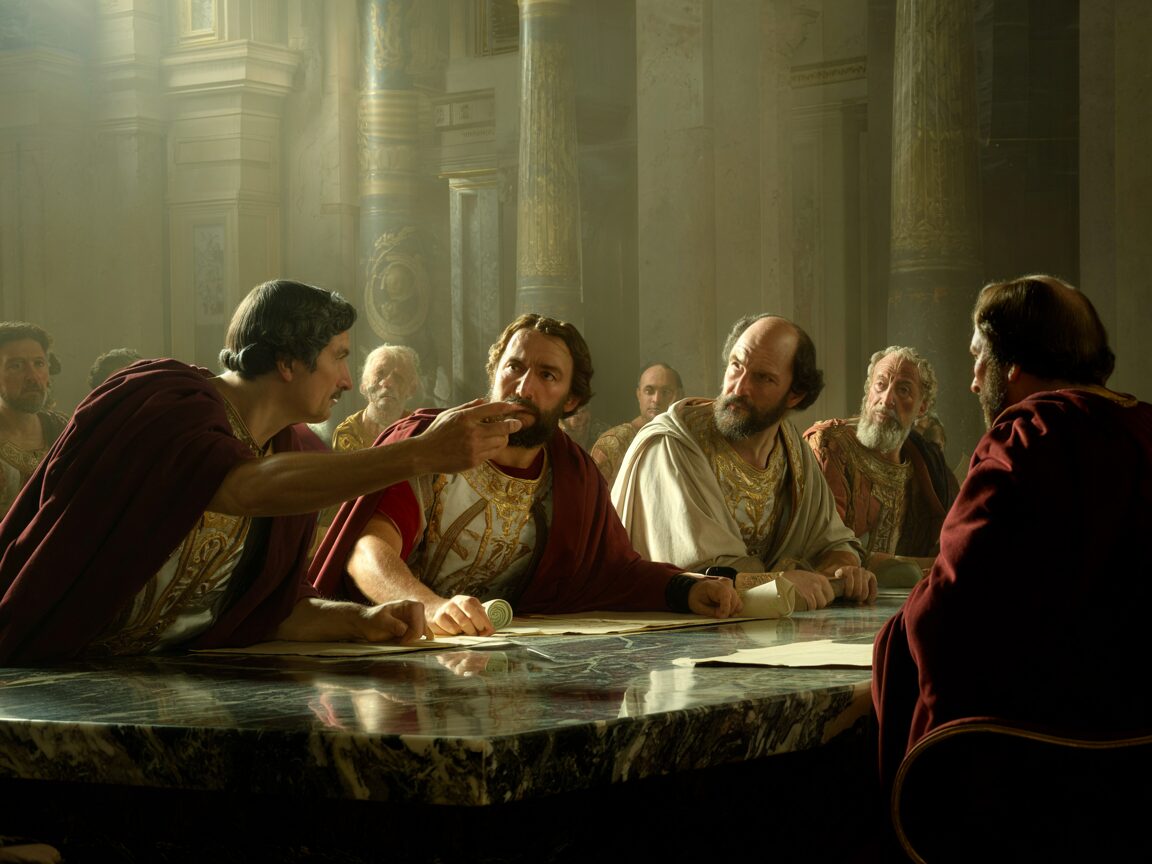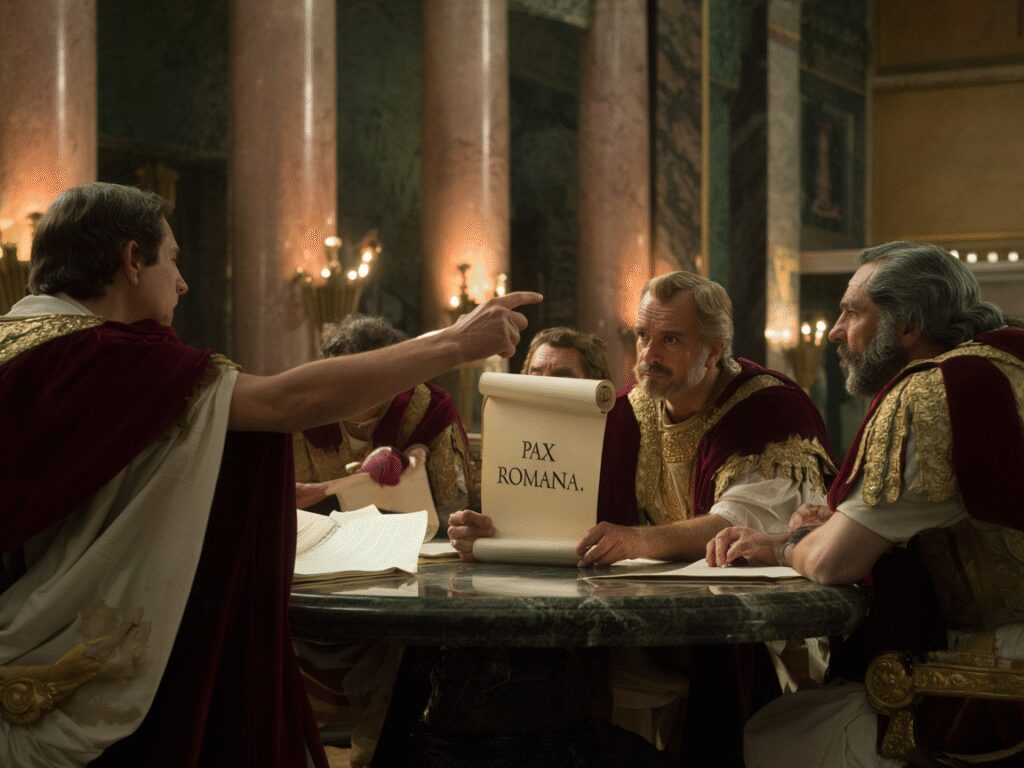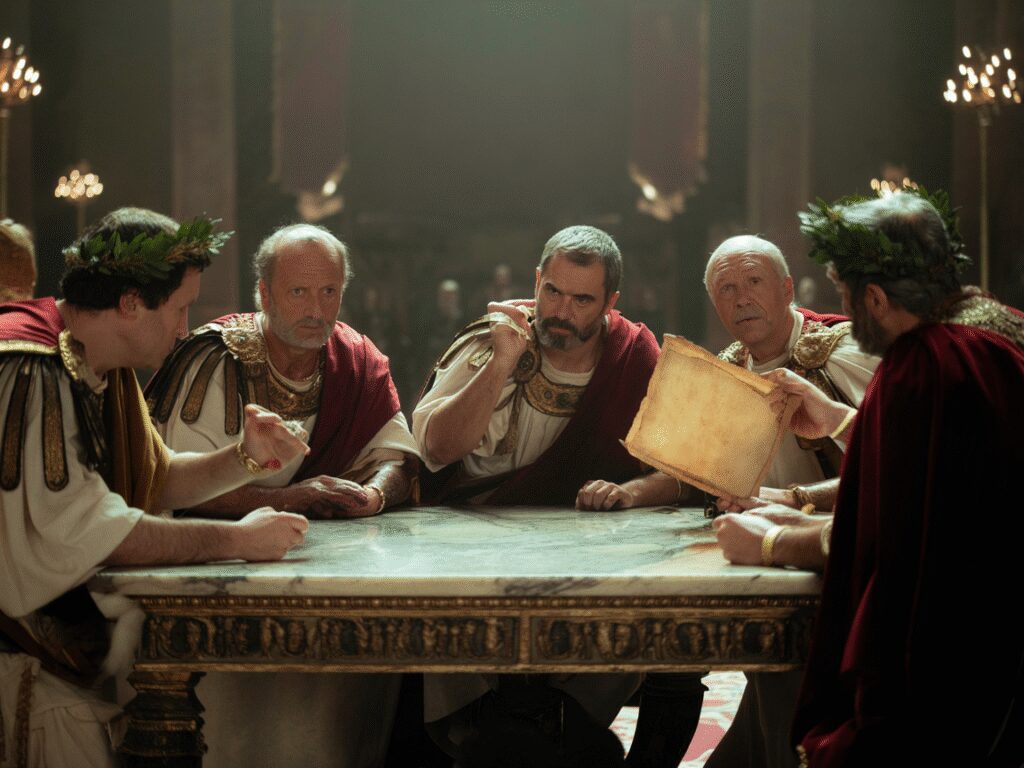Roman Diplomats: Negotiating Peace and War Across the Empire reveals the critical role of Roman diplomacy during Late Antiquity. This era, spanning roughly from the mid-fourth to late sixth century CE, showcased diplomacy as a vital instrument in managing the intricate balance between peace and war throughout the vast Roman Empire.
Diplomatic efforts were not mere formalities but essential mechanisms for maintaining stability amid diverse and often volatile regions. The changing geopolitical landscape, marked by rising powers and shifting alliances, directly influenced how Roman diplomats operated. Pressure from external threats and internal complexities demanded adaptable strategies that blended negotiation with displays of authority.
Understanding Roman diplomacy in this period highlights its significance beyond military might. It was a sophisticated practice involving negotiation, embassy missions, and symbolic exchanges—all aimed at securing peace or preparing for conflict when necessary. Moreover, this diplomatic finesse was often reflected in the art and culture of the time, which served as a medium for expressing power, influence, and identity across the empire.
The Role of Diplomacy in the Roman Empire
The Roman diplomatic system was crucial for maintaining stability in its vast and diverse empire. It wasn’t just about avoiding war but also managing relationships with different peoples, client kingdoms, and external powers. Diplomacy played a key role in peace negotiation by resolving disputes before they turned into open conflict, saving resources, and protecting Rome’s strategic interests.
Balancing Act of Roman Diplomats
Roman diplomats worked in a challenging environment where peace and war could easily shift. They had to find a balance between:
- Conflicting interests of various regions within the empire
- Diverse cultures and political systems of neighboring states
- Changing alliances that could quickly alter the geopolitical landscape
This delicate balancing act required skillful negotiation to prevent hostilities without showing weakness. Sometimes, diplomacy meant making strategic compromises or using symbolic gestures to reassure or intimidate foreign powers.
War Negotiation: More Than Just Ending Conflicts
In the context of war negotiation, diplomacy was used not only to end conflicts but also to manage ceasefires, prisoner exchanges, and terms of surrender. These negotiations directly impacted military campaigns and border security.
Frontline Agents of Imperial Strategy
Roman diplomats were important players in executing imperial strategy. They operated in a complex environment where diplomacy was closely linked with military and political goals.
Interestingly, the influence of Roman culture has transcended time, even finding its way into modern role-playing scenarios such as those in Second Life, where players immerse themselves in virtual worlds reminiscent of ancient Rome. Furthermore, the economic stability that allowed for such expansive diplomatic efforts was significantly bolstered by agriculture, which served as a crucial driver of Rome’s economic and social development.
Examples of Successful Roman Diplomacy
The success of Roman diplomacy is seen in historical events like those involving Scipio Africanus. His strategic military choices during the Second Punic War not only demonstrated the connection between diplomacy and military tactics but also established Rome’s supremacy over Carthage. This victory had significant implications for the Mediterranean region, further highlighting the significance of effective diplomatic strategies during wartime.
Influence of Religion on Diplomatic Practices
Moreover, it’s essential to recognize that these diplomatic practices were deeply influenced by ancient Roman religion, which formed a fundamental part of Roman identity throughout its history. Religion shaped various aspects including politics, culture, and social structures, thereby indirectly influencing the course of diplomatic relations both within and beyond the empire.

Institutional Framework of Roman Diplomacy
Roman diplomacy operated without a formal, professional diplomatic corps as seen in later states. Instead, it relied on a flexible network of diplomatic institutions anchored by envoys and interpreters. These individuals played specialized roles critical to successful negotiations and communication.
1. Envoys
Often selected from senators, equestrians, or trusted officials, envoys represented Rome’s interests abroad. Their missions varied from delivering messages to conducting complex treaty negotiations. Many envoys came from recurring diplomatic families, which accumulated experience and prestige over generations. This informal continuity provided a degree of expertise despite the absence of an official diplomatic service.
2. Interpreters
Communication across diverse languages was a persistent challenge. Interpreters bridged these gaps, facilitating dialogue with foreign powers. Although lacking formal training programs, interpreters held recognized official status under imperial administration. Their role was indispensable, especially in dealings with eastern neighbors and multiethnic border regions.
The institutional framework reflected a balance between hierarchy and flexibility. While embassies operated under imperial oversight, the system tolerated some duplication and inefficiency. This complexity allowed the empire to adapt to varied geopolitical contexts but limited the emergence of a rigid diplomatic bureaucracy. The reliance on trusted families and officials ensured that diplomatic knowledge and skills were preserved within certain circles, supporting Rome’s expansive and diverse foreign relations.
This diplomatic structure was part of a larger political framework that defined the governance of the Roman Republic, which marked a significant transition in governance from monarchy to a complex political structure laid the foundation for modern democracies. The structure of power during this period established key principles of governance that resonate today.
Moreover, it’s important to note how Roman law, stemming from this institutional framework, has played a crucial role in shaping modern legal systems. Its principles are still relevant in various legal systems today.
Additionally, the social dynamics within Rome were influenced by various factors including gender roles as highlighted in the article about the legal status of Roman women, which reflects a complex interplay of rights and restrictions significantly influencing gender dynamics in ancient Rome.
Lastly, while diplomacy played a vital role in Rome’s foreign relations, it was often supported by military might as exemplified by the Roman army. This military power was crucial in achieving victories across large areas which subsequently facilitated smoother diplomatic negotiations.

Diplomatic Missions and Embassy Practices
Embassy missions were the main way the Romans engaged with other countries. These missions usually included a mix of senators, experienced diplomats, and sometimes military advisors, all chosen for their skills in negotiation and understanding of the local culture. The main goals were to send messages from the emperor, make agreements, and resolve conflicts without going to war.
Crafting Negotiation Strategies
Negotiation strategies were carefully planned, focusing on showing respect for established customs and symbols. Roman diplomats followed specific protocols that involved formal greetings, public speeches, and organized gift exchanges. These actions reinforced Rome’s power while also allowing for compromise. Imperial officials often had a significant influence on the negotiation process, guiding envoys to align outcomes with broader strategic goals rather than just local interests.
Designated Venues for Diplomatic Dialogues
Diplomatic discussions often took place in specific locations such as heavily guarded cities on the borders or imperial palaces. These settings emphasized Rome’s dominance and control over the negotiations. Envoys were expected to behave appropriately, avoid direct confrontations, and carefully document agreements. The presence of imperial officials ensured that negotiations were not just ceremonial but also legally binding, reflecting the empire’s complex balance of diplomacy and showing off its power.
Shaping Outcomes through Formal Practices
Negotiating peace and war throughout the empire required not only skill but also following these official practices, which influenced diplomatic results in various geopolitical areas.
However, it’s important to remember that daily life in Ancient Rome was vastly different for various social classes. For instance, the social class divide significantly influenced individuals’ daily activities, traditions, and ways of living.
The story of Rome is not merely one of conquest and expansion; it is also a tale of innovation, culture, and governance that has left an indelible mark on the world. This rich history can be explored further in this detailed journey through Ancient Rome, which provides a comprehensive overview of its evolution from a small settlement along the Tiber River into one of the most powerful empires in history.

Symbolism and Gift Exchange in Roman Diplomacy
Gift exchange was a core feature of Roman diplomatic practice, functioning as a nuanced language beyond mere monetary transactions. These gifts were never simple payments or subsidies. Instead, they carried symbolic weight, often crafted to communicate respect, alliance, or dominance. The act of giving itself was a political gesture, reinforcing relationships between Rome and foreign powers or client kingdoms.
Key elements of gift exchange included:
- Expectation of reciprocation: Gifts established a cycle of mutual obligation. The recipient was socially and politically bound to respond in kind, fostering ongoing diplomatic engagement rather than one-sided generosity.
- Use of insignia: Items such as ceremonial robes, standards, or seals served to assert imperial authority and confer legitimacy. These insignia visually reinforced Rome’s power while recognizing the standing of allied rulers or envoys.
- Symbolic messages: Beyond material value, gifts conveyed subtle messages about hierarchy and friendship. Precious metals or exotic goods symbolized wealth and generosity; weapons or armor could imply military support or protection.
Roman diplomats carefully selected gifts that balanced respect with political intent. This form of symbolic diplomacy helped maintain delicate alliances across diverse cultures and languages within the empire’s sphere of influence. The ritualized exchange forged bonds that simple treaties alone could not secure.
The significance of these diplomatic practices can be further understood when we consider the broader context of Ancient Roman society, where entertainment such as gladiatorial games and chariot races played a crucial role in shaping social relationships and political authority. This intertwining of politics and spectacle is a testament to the complexity of Roman culture.
Moreover, the legal frameworks established during this period, such as those outlined in the Twelve Tables, also shaped the nature of these diplomatic exchanges by codifying legal practices that governed various aspects of Roman life.
The legacy of Ancient Rome, from its architectural masterpieces to its profound influence on Western civilization, continues to resonate today. The architectural innovations from this era serve not only as functional structures but also as enduring symbols of power and cultural identity.

Communication Challenges and Interpreters‘ Role in Negotiations
Roman diplomacy operated across a vast empire with numerous languages and dialects, making communication barriers a constant challenge. Interpreters were indispensable in bridging these linguistic divides during negotiations with foreign powers, client kingdoms, and various ethnic groups within the empire.
The Role of Interpreters in Roman Diplomacy
- Interpreters enabled dialogue between Roman envoys and their counterparts who often spoke languages such as Greek, Persian, Gothic, or various Germanic tongues.
- Their role went beyond mere translation; interpreters helped convey cultural nuances and diplomatic subtleties vital for successful negotiation outcomes.
The Status and Training of Interpreters
Despite their importance, interpreters lacked formalized training or a standardized professional status. Their skills were often acquired through experience, multilingual upbringing, or close association with imperial officials.
“Interpreters were recognized as necessary but remained somewhat informal actors within the diplomatic process.”
Some interpreters held official positions tied to imperial administration, suggesting partial acknowledgment of their role’s significance. This limited institutionalization meant reliability varied, and diplomatic messages could be distorted, intentionally or inadvertently.
The Significance of Interpreters in Roman Diplomacy
The presence of interpreters highlighted the complexities of Roman diplomatic efforts, where language differences posed risks but also opportunities to exercise influence through careful communication management. Their function was vital in an empire that negotiated peace and war across diverse cultures and tongues.

Case Study: Diplomacy with Sasanian Persia
Roman-Sasanian relations represent one of the most complex and enduring diplomatic challenges faced by Roman diplomats. The two empires, often locked in conflict over control of the eastern frontier, also engaged in sustained diplomatic exchanges to manage peace and war. These interactions involved envoys negotiating treaties, prisoner exchanges, and border agreements, reflecting a pragmatic approach to coexistence despite frequent hostilities.
1. Limited surviving evidence
Documentation of Roman diplomacy with the Sasanians is fragmentary, scattered across inscriptions, coinage, and occasional historical accounts. This scarcity complicates a full reconstruction of diplomatic practices but highlights the importance of interpreting available sources carefully.
2. Significance for eastern frontier policy
The diplomacy with Sasanian Persia reveals how Rome balanced military pressure with negotiation to stabilize a volatile border. Envoys acted not only as messengers but as crucial agents in shaping imperial strategy, navigating cultural differences, and asserting Roman prestige.
3. Diplomatic challenges
Communication barriers demanded skilled interpreters.
The high stakes of territorial control necessitated careful gift exchanges and symbolic gestures.
Envoys had to manage shifting alliances with local client states caught between Rome and Persia.
These factors underscore the essential role of diplomacy in managing one of Rome’s most strategically sensitive regions. Understanding Roman-Sasanian diplomacy enriches perspectives on how Roman diplomats negotiated peace and war across the empire’s diverse frontiers.

The Impact of Geopolitical Changes on Roman Diplomatic Strategies
Geopolitical changes during Late Antiquity forced the Roman Empire to constantly adjust its diplomatic strategies, particularly in the eastern part of the empire. The rise of new powers and shifting alliances changed how Rome viewed threats and opportunities along its borders.
Key factors influencing diplomatic strategy included:
- Pressure from emerging barbarian groups: As Germanic tribes moved closer to imperial frontiers, Rome sought to use diplomacy to manage these groups as foederati or buffer states rather than confront them in costly wars.
- Sasanian resurgence: Persistent rivalry with Sasanian Persia demanded sustained negotiation efforts, balancing military engagements with diplomatic exchanges to avoid prolonged conflict.
- Internal instability: Civil wars and political fragmentation within the empire sometimes weakened Rome’s negotiating position, prompting more cautious diplomacy or reliance on local intermediaries.
- Changing alliances among neighboring states: Shifting loyalties among client kingdoms and tribes required Rome to adapt its gift-giving and treaty-making practices to maintain influence.
The adjustments made in their strategies showed a more practical approach. Instead of sticking to strict territorial claims, Rome focused on flexible treaties, temporary truces, and symbolic gift exchanges. Emperors often used diplomatic missions as a way to buy time for military reorganization or take advantage of rivalries between external powers.
Diplomacy became a tool not only for keeping peace but also for managing uncertainty in a constantly changing geopolitical environment. This ability to adapt helped the empire maintain relative stability despite ongoing external pressures and internal challenges.
The Role of Socio-Economic Conditions
The internal challenges faced by the Roman Empire were not solely caused by external pressures. They were also influenced by the socio-economic conditions within the empire. A significant portion of the population, known as plebeians, played a crucial role in shaping these dynamics. Plebeians represented the majority of free citizens who were not part of the patrician elite, and their lives significantly influenced the development of political and economic structures in Rome.
The Influence of Patricians
While diplomacy was essential in managing relationships with external entities, it was equally important in maintaining internal stability. The patricians, being the wealthy elite, had substantial influence over governance and societal norms. Their relationship with plebeians could either stabilize or destabilize the internal structure depending on how it was managed.
The Importance of Engineering Feats
Roman engineering achievements played a crucial role in ensuring effective governance and cultural exchange across vast regions. These incredible engineering feats not only facilitated military movements but also helped integrate diverse cultures within the empire. This integration further enhanced diplomatic relations between different groups.
Understanding Political Transitions
To fully grasp the complexities of Roman governance, it is important to understand the transition from monarchy to a republican system. This shift marked a significant moment in history that shaped modern political structures.
Conclusion
Roman diplomacy had its own distinctive characteristics that combined formal rituals with practical negotiations, which were crucial in managing the vast and diverse empire. Without a centralized diplomatic corps, the system was flexible but often inefficient, relying on trusted envoys and interpreters to navigate complex geopolitical situations. Gift exchanges and symbolic gestures reinforced alliances without direct monetary dependency, showing a sophisticated understanding of influence and authority.
Despite facing challenges from bureaucratic complexity and inconsistent communication, Roman diplomats were able to maintain peacekeeping mechanisms across unstable frontiers. Their approach combined military readiness with diplomatic engagement, allowing Rome to negotiate peace and war effectively.
The legacy of Roman diplomacy goes beyond ancient times, influencing medieval and early modern European diplomatic practices. Later traditions echo practices such as embassy missions, gift-giving as political language, and the strategic use of interpreters.
Understanding Roman Diplomats: Negotiating Peace and War Across the Empire offers valuable insights into the foundations of international relations as we know them today.
Moreover, the rise and fall of the Roman Empire has left a lasting impact on the world, shaping politics, culture, and society in ways that still resonate today. This ancient civilization was not just a political entity; it was a rich tapestry made up of various cultures, languages, and traditions.
Additionally, the principles outlined in the Corpus Juris Civilis, commissioned by Emperor Justinian I in the 6th century AD, preserved ancient Roman legal principles while adapting them to contemporary society’s needs. This comprehensive codification marked a crucial turning point in the development of legal systems, especially in Europe.
Furthermore, Stoicism, a philosophical school founded by Zeno of Citium around 300 BCE in ancient Greece, became popular in Roman culture. Its main principles emphasized living in harmony with nature, using reason, and practicing virtue as paths to achieving eudaimonia or human flourishing.
Finally, the influence of Roman mythology on modern culture is another testament to the enduring legacy of this ancient civilization. The Romans adapted Greek myths to reflect their own societal norms and political aspirations.
FAQs (Frequently Asked Questions)
What was the significance of Roman diplomacy during Late Antiquity in managing peace and war across the empire?
Roman diplomacy in Late Antiquity played a crucial role in managing the delicate balance between peace and conflict across the vast empire. It served as a key tool for maintaining stability amid changing geopolitical contexts, enabling Rome to negotiate peace and war effectively with diverse regions and external powers.
How was the Roman diplomatic system organized without a formal professional diplomatic corps?
The Roman diplomatic system lacked a formal professional diplomatic corps but relied on recurring diplomatic families and appointed envoys and interpreters to conduct negotiations. This institutional framework enabled flexible and adaptive diplomatic efforts, with envoys representing imperial interests and interpreters facilitating communication across multiple languages.
What were the main components and protocols of Roman embassy missions during diplomatic negotiations?
Roman embassy missions typically consisted of carefully selected envoys who followed established negotiation strategies and protocols influenced by imperial officials. These missions aimed to engage foreign powers through formalized exchanges, adhering to customs that ensured respect, authority assertion, and successful negotiation outcomes.
Why was gift exchange important in Roman diplomacy, and how did it function symbolically?
Gift exchange in Roman diplomacy functioned as a symbolic language distinct from monetary subsidies. Gifts carried expectations of reciprocation and served to assert authority through insignia and other tokens. This practice reinforced alliances, communicated respect, and maintained diplomatic relationships across different cultures within the empire.
What challenges did Roman diplomats face regarding communication, and what role did interpreters play?
Roman diplomats encountered significant communication barriers due to the empire’s linguistic diversity. Interpreters were essential for multilingual negotiations despite lacking formal training. Their recognized official status helped bridge language gaps, ensuring accurate dialogue and facilitating effective diplomatic exchanges.
How did geopolitical changes during Late Antiquity impact Roman diplomatic strategies, especially concerning relations with Sasanian Persia?
Evolving threats from external powers during Late Antiquity prompted Rome to adjust its diplomatic priorities and strategies. Despite limited surviving records, diplomacy with Sasanian Persia exemplifies these shifts, highlighting Rome’s efforts to manage eastern frontier policy through complex diplomatic exchanges that balanced power dynamics amid changing regional geopolitics.

